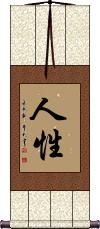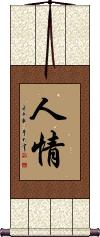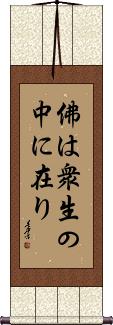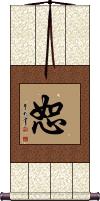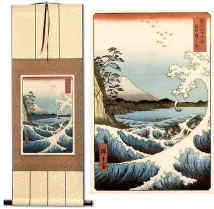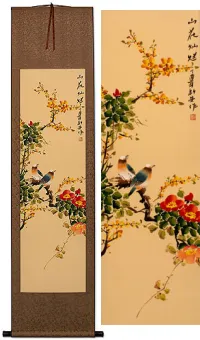Many custom options...
And formats...

Not what you want?
Try other similar-meaning words, fewer words, or just one word.
Human Nature in Chinese / Japanese...
Buy a Human Nature calligraphy wall scroll here!
Personalize your custom “Human Nature” project by clicking the button next to your favorite “Human Nature” title below...
1. Human Nature
4. Fire and Water Have No Mercy
5. The Buddha is in Each Sentient Being
6. Forgiveness
Human Nature
人性 is a title that is the essence of what it means to act and be human.
These two characters refer to the way we are as people.
人性 is also sometimes translated as human personality, human instinct, humanity, or humanism.
The first character literally means human or people.
The second character means nature. It can also mean property, quality, attribute, or essence. It can even be a modifier like “-ity” or “-ness,” which is why this word is also translated as “humanity.”
Empathy / Humanity
人情 is a title that can apply to a lot of meanings, including humanity, empathy, kindness, sympathy, human nature, human emotions, or human interaction.
Life is a Dew Drop
人生朝露 is a proverb that means “human life is like morning dew.”
Figuratively, this suggests the ephemeral and precarious nature of human existence.
Also translated as:
Man's life vanishes like a drop of dew.
A person's life is as fleeting as morning dew.
Life is as transient as morning due.
Fire and Water Have No Mercy
The Buddha is in Each Sentient Being
佛は衆生の中に在り is “Butsu wa shujo no naka ni ari” and means that the Buddha (potential for Buddhahood) exists in all beings in the universe.
So yes, your dog has the potential to be a Buddha (but only in a future reincarnation as a human). But all things, from the tiny cricket to the humpback whale have Buddha nature within them. If one takes the time to look and contemplate, one will see the Buddha in all things.
In Japan, sometimes the Buddha character is written 仏 instead of 佛, so you might see the whole phrase written as 仏は衆生の中に在り.
Note: Because this selection contains some special Japanese Hiragana characters, it should be written by a Japanese calligrapher.
Forgiveness
恕 means to forgive, show mercy, absolve, or excuse in Chinese and Korean Hanja (though mostly used in compound words in Korean).
恕 incorporates the pictogram of a heart at the bottom, and a woman and a mouth at the top. The heart portion has the most significance, as it is suggested that it is the heart's nature to forgive.
In Asian culture, as with most other cultures, forgiveness is an act of benevolence and altruism. In forgiving, you put yourself in someone else's shoes and show them the kindness that you would want them to show you. Confucius referred to this quality as “human-heartedness.”
This in-stock artwork might be what you are looking for, and ships right away...
Gallery Price: $108.00
Your Price: $59.88
Gallery Price: $108.00
Your Price: $59.88
Not the results for human nature that you were looking for?
Below are some entries from our dictionary that may match your human nature search...
| Characters If shown, 2nd row is Simp. Chinese |
Pronunciation Romanization |
Simple Dictionary Definition |
人性 see styles |
rén xìng ren2 xing4 jen hsing jinsei / jinse じんせい |
More info & calligraphy: Human Naturehuman nature; instinct; humanity; humanism |
人情 see styles |
rén qíng ren2 qing2 jen ch`ing jen ching ninjou / ninjo にんじょう |
More info & calligraphy: Empathy / Humanity(1) humanity; empathy; kindness; sympathy; (2) human nature; common sense; customs and manners human emotions |
化身 see styles |
huà shēn hua4 shen1 hua shen keshin けしん |
More info & calligraphy: Avatar(n,vs,adj-no) {Buddh} incarnation; impersonation; personification; avatar nirmāṇakāya, 應身, 應化身; 變化身 The third characteristic or power of the trikāya 三身, a Buddha's metamorphosic body, which has power to assume any shape to propagate the Truth. Some interpret the term as connoting pan-Buddha, that all nature in its infinite variety is the phenomenal 佛身 Buddha-body. A narrower interpretation is his appearance in human form expressed by 應身, while 化身 is used for his manifold other forms of appearances. |
自然 see styles |
zì rán zi4 ran2 tzu jan minori みのり |
More info & calligraphy: Nature(n,adv) (dated) occurring naturally (without human influence); (female given name) Minori svayaṃbhū, also 自爾; 法爾 self-existing, the self-existent; Brahmā, Viṣṇu, and others; in Chinese it is 'self-so', so of itself, natural, of course, spontaneous. It also means uncaused existence, certain sects of heretics 自然外道 denying Buddhist cause and effect and holding that things happen spontaneously. |
人生朝露 see styles |
rén shēng zhāo lù ren2 sheng1 zhao1 lu4 jen sheng chao lu jinseichouro / jinsechoro じんせいちょうろ |
More info & calligraphy: Life is a Dew Drop(expression) (yoji) man's life vanishes like a dew; a person's life is as fleeting as a morning dew |
人 see styles |
rén ren2 jen hitotaka ひとたか |
person; people; CL:個|个[ge4],位[wei4] (1) person; someone; somebody; (2) human beings; mankind; man; people; humans; (3) (kana only) (usu. ヒト) human (Homo sapiens); (4) (other) people; others; (5) character; personality; nature; (6) capable person; competent person; suitable person; right person; (7) adult; grown-up; (8) (used when rebuking or criticizing someone) I; me; one; (surname) Hitotaka manuṣya; nara; puruṣa; pudgala. Man, the sentient thinking being in the desire-realm, whose past deeds affect his present condition. |
根 see styles |
gēn gen1 ken nemawari ねまわり |
root; basis; classifier for long slender objects, e.g. cigarettes, guitar strings; CL:條|条[tiao2]; radical (chemistry) (1) root (of a plant); (2) root (of a tooth, hair, etc.); center (of a pimple, etc.); (3) root (of all evil, etc.); source; origin; cause; basis; (4) one's true nature; (5) (fishing) reef; (personal name) Nemawari mūla, a root, basis, origin; but when meaning an organ of sense, indriyam, a 'power', 'faculty of sense, sense, organ of sense'. M.W. A root, or source; that which is capable of producing or growing, as the eye is able to produce knowledge, as faith is able to bring forth good works, as human nature is able to produce good or evil karma. v. 五根 and 二十二根. |
世情 see styles |
shì qíng shi4 qing2 shih ch`ing shih ching sejou / sejo せじょう |
worldly affairs; the ways of the world the ways of the world; human nature |
二我 see styles |
èr wǒ er4 wo3 erh wo niga |
(二我見) The two erroneous views of individualism: (a) 人我見 The erroneous view that there is an independent human personality or soul, and (b) 法我見 the like view that anything exists with an independent nature. |
五教 see styles |
wǔ jiào wu3 jiao4 wu chiao gokyō |
The five division of Buddhism according to the Huayan School, of which there are two That of 杜順 Dushun down to 賢首 Xianshou is (1) 小乘教 Hīnayāna which interprets nirvana as annihilation; (2) 大乘始教 the primary stage of Mahāyāna, with two sections the 相始教 and 空 始教 or realistic and idealistic, (3) 大乘終教 Mahāyāna in its final stage, teaching the 眞如 and universal Buddhahood; (4) 頓教 the immediate, direct, or intuitive school, e. g. by right concentration of thought, or faith, apart from 'works'; (5) 圓教 the complete or perfect teaching of the Huayan, combining all the rest into one all-embracing vehicle. The five are now differentiated into 十宗 ten schools. The other division, by 圭峯 Guifeng of the same school, is (1) 人天教 rebirth as human beings for those who keep the five commandments and as devas those who keep the 十善 as 相始教 above; (4) 大乘破相教 as 空始教 above; and (5) 一乘顯性教 the one vehicle which reveals the universal Buddha-nature; it includes (3), (4), and (5) of the first group. See also 五時教. |
五蘊 五蕴 see styles |
wǔ yùn wu3 yun4 wu yün goun / gon ごうん |
the Five Aggregates (from Sanskrit "skandha") (Buddhism) {Buddh} the five skandhas (matter, sensation, perception, mental formations and consciousness); the five aggregates The five skandhas, pañca-skandha: also 五陰; 五衆; 五塞犍陀 The five cumulations, substances, or aggregates, i. e. the components of an intelligent being, specially a human being: (1) 色 rūpa, form, matter, the physical form related to the five organs of sense; (2) 受 vedana, reception, sensation, feeling, the functioning of the mind or senses in connection with affairs and things; (3) 想 saṃjñā, conception, or discerning; the functioning of mind in distinguishing; (4) 行 saṃskāra, the functioning of mind in its processes regarding like and dislike, good and evil, etc.; (5) 識 vijñāna, mental faculty in regard to perception and cognition, discriminative of affairs and things. The first is said to be physical, the other four mental qualities; (2), (3), and (4) are associated with mental functioning, and therefore with 心所; (5) is associated with the faculty or nature of the mind 心王 manas. Eitel gives— form, perception, consciousness, action, knowledge. See also Keith's Buddhist Philosophy, 85-91. |
人心 see styles |
rén xīn ren2 xin1 jen hsin jinshin じんしん |
popular feeling; the will of the people (1) human nature; human heart; human spirit; kindness; sympathy; (2) (じんしん only) public feeling; people's sentiments; (3) (ひとごころ only) (See 人心地・ひとごこち・1) consciousness; awareness; (given name) Jinshin minds of men |
人本 see styles |
rén běn ren2 ben3 jen pen ninhon |
the nature of human beings |
六趣 see styles |
liù qù liu4 qu4 liu ch`ü liu chü rokushu |
The six directions of reincarnation, also 六道: (1) 地獄趣 naraka-gati, or that of the hells; (2) 餓鬼趣 preta-gati, of hungry ghosts; (3) 畜生趣 tiryagyoni-gati, of animals; (4) 阿修羅趣 asura-gati, of malevolent nature spirits; (5 ) 人趣 manuṣya-gati, of human existence; (6) 天趣 deva-gati, of deva existence. The 六趣輪廻經 is attributed to Aśvaghoṣa. |
天眞 see styles |
tiān zhēn tian1 zhen1 t`ien chen tien chen tenma てんま |
(female given name) Tenma bhūtatathatā, permanent reality underlying all phenomena, pure and unchanging e. g. the sea in contrast with the waves; nature, the natural, 天然之眞理, 非人之造作者 natural reality, not of human creation. |
性理 see styles |
xìng lǐ xing4 li3 hsing li shōri |
human nature and natural laws |
薤露 see styles |
kairo かいろ |
ephemeral nature of the human world; transience of life; dew on onion leaves (i.e. tears that mourn a death) |
遮制 see styles |
zhē zhì zhe1 zhi4 che chih shasei |
遮戒 A secondary commandment, deriving from the mandate of Buddha, e.g. against drinking wine, as opposed to 性戒 a commandment based on the primary laws of human nature, e.g. against murder, etc.; cf 二戒. |
人の常 see styles |
hitonotsune ひとのつね |
(exp,n) human nature |
人情咄 see styles |
ninjoubanashi / ninjobanashi にんじょうばなし |
story about human nature or emotions (esp. rakugo); emotional rakugo story lacking a punch line |
人情噺 see styles |
ninjoubanashi / ninjobanashi にんじょうばなし |
story about human nature or emotions (esp. rakugo); emotional rakugo story lacking a punch line |
人情話 see styles |
ninjoubanashi / ninjobanashi にんじょうばなし |
story about human nature or emotions (esp. rakugo); emotional rakugo story lacking a punch line |
人間性 see styles |
ningensei / ningense にんげんせい |
humanity; human nature |
性善説 see styles |
seizensetsu / sezensetsu せいぜんせつ |
(orig. from Mencius) (ant: 性悪説) belief that human nature is fundamentally good |
性悪説 see styles |
seiakusetsu / seakusetsu せいあくせつ |
(ant: 性善説) cynicism (of mankind); belief that human nature is fundamentally evil |
性惡論 性恶论 see styles |
xìng è lùn xing4 e4 lun4 hsing o lun |
"human nature is evil", theory advocated by Xunzi 荀子[Xun2 zi3] |
胎藏界 see styles |
tāi zàng jiè tai1 zang4 jie4 t`ai tsang chieh tai tsang chieh taizō kai |
Garbhadhātu, or Garbhakośa-(dhātu), the womb treasury, the universal source from which all things are produced; the matrix; the embryo; likened to a womb in which all of a child is conceived— its body, mind, etc. It is container and content; it covers and nourishes; and is the source of all supply. It represents the 理性 fundamental nature, both material elements and pure bodhi, or wisdom in essence or purity; 理 being the garbhadhātu as fundamental wisdom, and 智 acquired wisdom or knowledge, the vajradhātu. It also represents the human heart in its innocence or pristine purity, which is considered as the source of all Buddha-pity and moral knowledge. And it indicates that from the central being in the maṇḍala, viz. the Sun as symbol of Vairocana, there issue all the other manifestations of wisdom and power, Buddhas, bodhisattvas, demons, etc. It is 本覺 original intellect, or the static intellectuality, in contrast with 始覺 intellection, the initial or dynamic intellectuality represented in the vajradhātu; hence it is the 因 cause and vajradhātu the 果 effect; though as both are a unity, the reverse may be the rule, the effect being also the cause; it is also likened to 利他 enriching others, as vajradhātu is to 自利 enriching self. Kōbō Daishi, founder of the Yoga or Shingon 眞言 School in Japan, adopted the representation of the ideas in maṇḍalas, or diagrams, as the best way of revealing the mystic doctrine to the ignorant. The garbhadhātu is the womb or treasury of all things, the universe; the 理 fundamental principle, the source; its symbols are a triangle on its base, and an open lotus as representing the sun and Vairocana. In Japan this maṇḍala is placed on the east, typifying the rising sun as source, or 理. The vajradhātu is placed west and represents 智 wisdom or knowledge as derived from 理 the underlying principle, but the two are essential one to the other, neither existing apart. The material and spiritual; wisdom-source and intelligence; essence and substance; and similar complementary ideas are thus portrayed; the garbhadhātu may be generally considered as the static and the vajradhātu as the dynamic categories, which are nevertheless a unity. The garbhadhātu is divided into 三部 three sections representing samādhi or quiescence, wisdom-store, and pity-store, or thought, knowledge, pity; one is called the Buddha-section, the others the Vajra and Lotus sections respectively; the three also typify vimokṣa, prajñā, and dharmakāya, or freedom, understanding, and spirituality. There are three heads of these sections, i. e. Vairocana, Vajrapāṇi, and Avalokiteśvara; each has a mother or source, e. g. Vairocana from Buddha's-eye; and each has a 明王 or emanation of protection against evil; also a śakti or female energy; a germ-letter, etc. The diagram of five Buddhas contains also four bodhisattvas, making nine in all, and there are altogether thirteen 大院 or great courts of various types of ideas, of varying numbers, generally spoken of as 414. Cf. 金剛界; 大日; 兩部. |
二種忍辱 二种忍辱 see styles |
èr zhǒng rěn rù er4 zhong3 ren3 ru4 erh chung jen ju nishuninniku |
Two kinds of patience, or endurance: (a) of the assaults of nature, heat, cold, etc.; (b) of human assaults and insults. |
人之常情 see styles |
rén zhī cháng qíng ren2 zhi1 chang2 qing2 jen chih ch`ang ch`ing jen chih chang ching |
human nature (idiom); a behavior that is only natural |
人定勝天 人定胜天 see styles |
rén dìng shèng tiān ren2 ding4 sheng4 tian1 jen ting sheng t`ien jen ting sheng tien |
man can conquer nature (idiom); human wisdom can prevail over nature |
Click here for more human nature results from our dictionary
The following table may be helpful for those studying Chinese or Japanese...
| Title | Characters | Romaji (Romanized Japanese) | Various forms of Romanized Chinese | |
| Human Nature | 人性 | rén xìng / ren2 xing4 / ren xing / renxing | jen hsing / jenhsing | |
| Empathy Humanity | 人情 | ninjou / ninjo | rén qíng / ren2 qing2 / ren qing / renqing | jen ch`ing / jenching / jen ching |
| Life is a Dew Drop | 人生朝露 | jin sei chou ro jinseichouro jin sei cho ro | rén shēng zhāo lù ren2 sheng1 zhao1 lu4 ren sheng zhao lu renshengzhaolu | jen sheng chao lu jenshengchaolu |
| Fire and Water Have No Mercy | 水火無情 水火无情 | shuǐ huǒ wú qíng shui3 huo3 wu2 qing2 shui huo wu qing shuihuowuqing | shui huo wu ch`ing shuihuowuching shui huo wu ching |
|
| The Buddha is in Each Sentient Being | 佛は衆生の中に在り | butsu wa shujou no naka ni ari butsuwashujounonakaniari butsu wa shujo no naka ni ari | ||
| Forgiveness | 恕 | shù / shu4 / shu | ||
| In some entries above you will see that characters have different versions above and below a line. In these cases, the characters above the line are Traditional Chinese, while the ones below are Simplified Chinese. | ||||
Successful Chinese Character and Japanese Kanji calligraphy searches within the last few hours...
